Research Report: Strategic Management and Analysis of FedEx Corp.
VerifiedAdded on 2023/06/03
|11
|2010
|95
Report
AI Summary
This research report provides a comprehensive analysis of FedEx Corporation, focusing on strategic management, leadership, planning, and environmental constraints within the logistics and transportation industry. Founded in 1971 by Frederick W. Smith, FedEx operates across four segments: FedEx Ground, FedEx Service, FedEx Express, and FedEx Freight, employing over 210,000 individuals worldwide. The report details FedEx's customer base, mission, vision, and core values, and examines corporate and business-level strategies, including international growth, e-commerce development, and differentiation through superior customer service. A SWOT analysis identifies key strengths, weaknesses, opportunities, and threats, such as innovative technology, operational inefficiencies, growth in Asia-Pacific markets, and intense market competition. The analysis concludes that FedEx is a capable company with future growth potential, recommending cost negotiation and operational flexibility to address identified weaknesses and threats. Desklib provides this document and many other resources to support students in their academic endeavors.
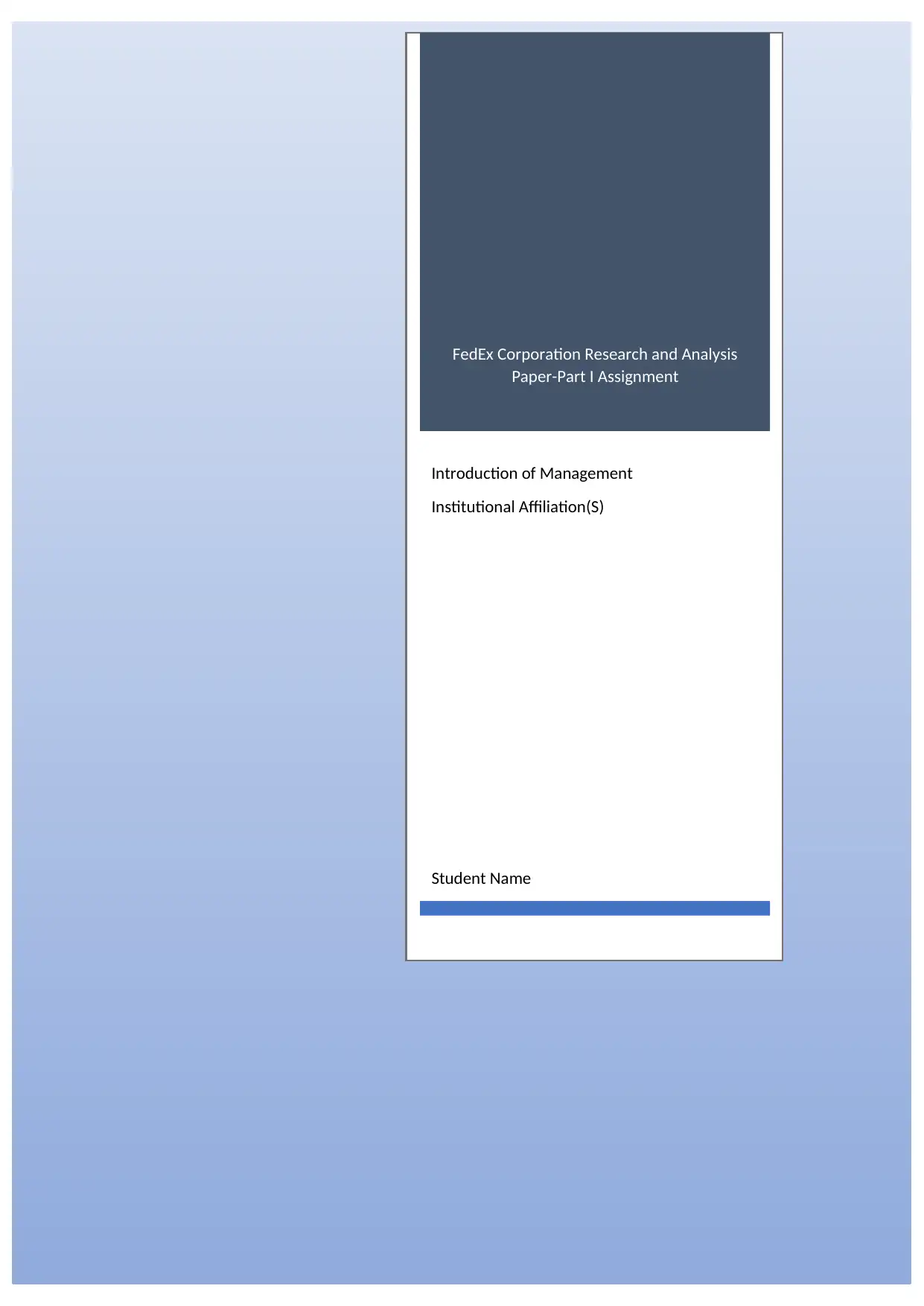
FedEx Corporation Research and Analysis
Paper-Part I Assignment
Introduction of Management
Institutional Affiliation(S)
Student Name
Paper-Part I Assignment
Introduction of Management
Institutional Affiliation(S)
Student Name
Paraphrase This Document
Need a fresh take? Get an instant paraphrase of this document with our AI Paraphraser
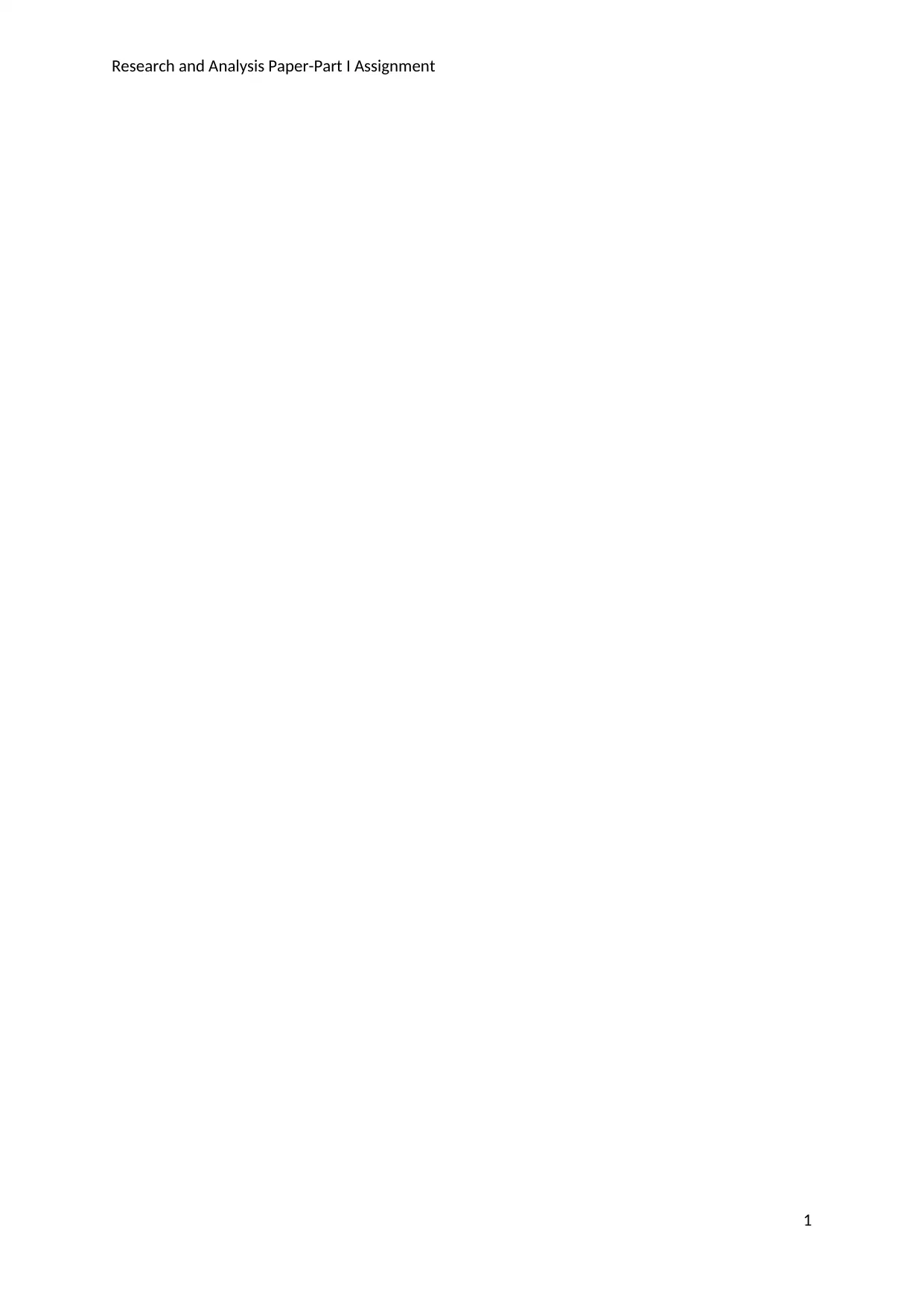
Research and Analysis Paper-Part I Assignment
1
1
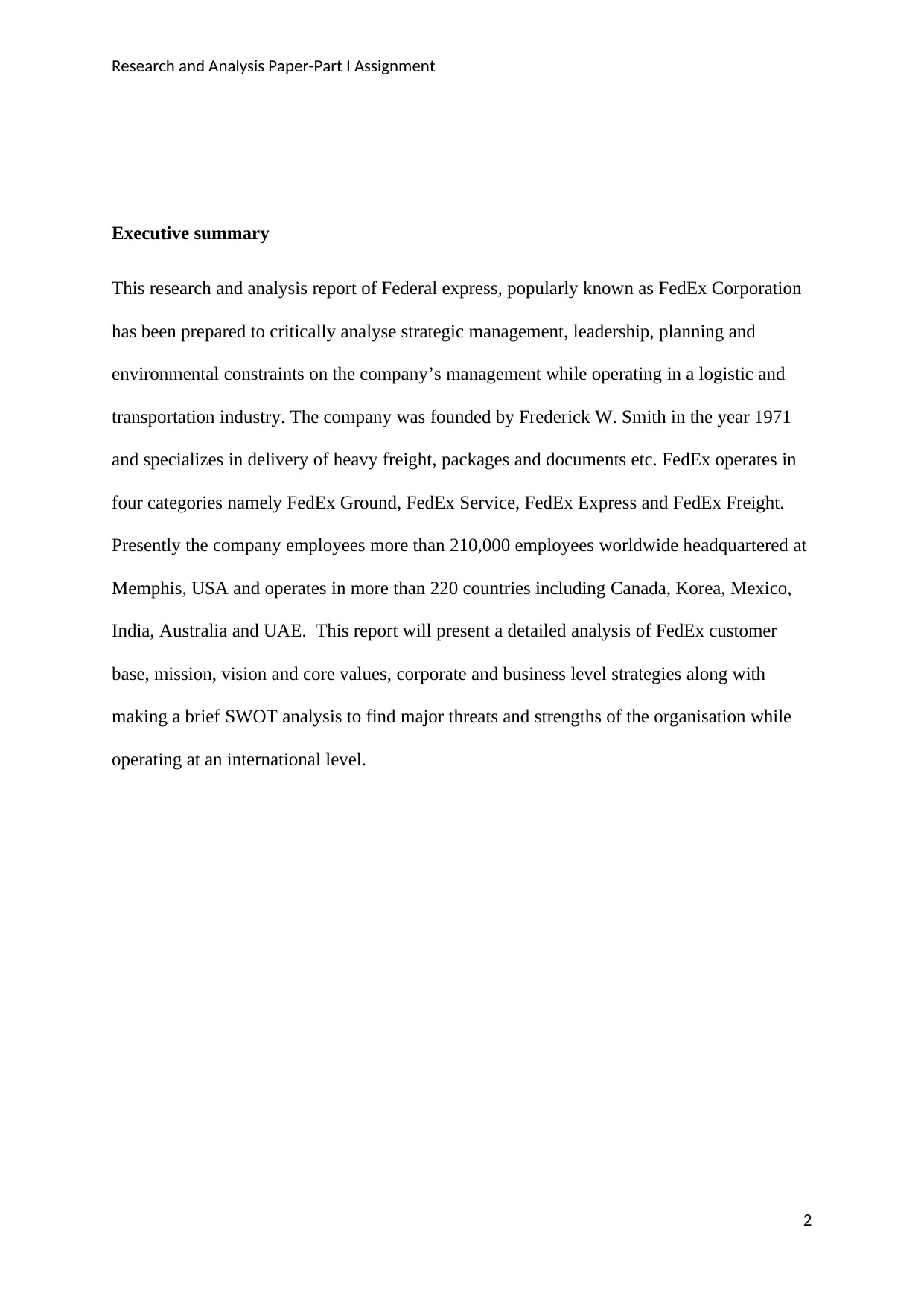
Research and Analysis Paper-Part I Assignment
Executive summary
This research and analysis report of Federal express, popularly known as FedEx Corporation
has been prepared to critically analyse strategic management, leadership, planning and
environmental constraints on the company’s management while operating in a logistic and
transportation industry. The company was founded by Frederick W. Smith in the year 1971
and specializes in delivery of heavy freight, packages and documents etc. FedEx operates in
four categories namely FedEx Ground, FedEx Service, FedEx Express and FedEx Freight.
Presently the company employees more than 210,000 employees worldwide headquartered at
Memphis, USA and operates in more than 220 countries including Canada, Korea, Mexico,
India, Australia and UAE. This report will present a detailed analysis of FedEx customer
base, mission, vision and core values, corporate and business level strategies along with
making a brief SWOT analysis to find major threats and strengths of the organisation while
operating at an international level.
2
Executive summary
This research and analysis report of Federal express, popularly known as FedEx Corporation
has been prepared to critically analyse strategic management, leadership, planning and
environmental constraints on the company’s management while operating in a logistic and
transportation industry. The company was founded by Frederick W. Smith in the year 1971
and specializes in delivery of heavy freight, packages and documents etc. FedEx operates in
four categories namely FedEx Ground, FedEx Service, FedEx Express and FedEx Freight.
Presently the company employees more than 210,000 employees worldwide headquartered at
Memphis, USA and operates in more than 220 countries including Canada, Korea, Mexico,
India, Australia and UAE. This report will present a detailed analysis of FedEx customer
base, mission, vision and core values, corporate and business level strategies along with
making a brief SWOT analysis to find major threats and strengths of the organisation while
operating at an international level.
2
⊘ This is a preview!⊘
Do you want full access?
Subscribe today to unlock all pages.

Trusted by 1+ million students worldwide

Research and Analysis Paper-Part I Assignment
Table of Contents
Introduction................................................................................................................................3
Customer base............................................................................................................................3
Mission and Core Values...........................................................................................................3
Vision.........................................................................................................................................4
Corporate level strategies...........................................................................................................4
Business level strategies.............................................................................................................5
SWOT analysis...........................................................................................................................6
Strengths.................................................................................................................................6
Weaknesses.............................................................................................................................6
Opportunities..........................................................................................................................7
Threats....................................................................................................................................7
Conclusion..................................................................................................................................7
References..................................................................................................................................9
3
Table of Contents
Introduction................................................................................................................................3
Customer base............................................................................................................................3
Mission and Core Values...........................................................................................................3
Vision.........................................................................................................................................4
Corporate level strategies...........................................................................................................4
Business level strategies.............................................................................................................5
SWOT analysis...........................................................................................................................6
Strengths.................................................................................................................................6
Weaknesses.............................................................................................................................6
Opportunities..........................................................................................................................7
Threats....................................................................................................................................7
Conclusion..................................................................................................................................7
References..................................................................................................................................9
3
Paraphrase This Document
Need a fresh take? Get an instant paraphrase of this document with our AI Paraphraser

Research and Analysis Paper-Part I Assignment
Introduction
FedEx offers varied range of transportation and logistics service accommodating extensive
range of cargos. The shipment industry can further be classified according to the nature and
matureness stage in the industry life period and to find out the same, this report will analyse
the case study of FedEx. Although there are few competitors of FedEx, the company have
established itself through its own brand reputation that gains loyalty among its customers.
Along with it, the company follows low cost operations that further helps the company in
gaining international recognition (Wood, 2003).
Customer base
FedEx customers belongs to diversified segments and various classes including industries,
individual customers and government organisations who seek several logistics solutions.
FedEx customers are not only limited to urban areas only, but the company also delivers in
rural and suburbs situated worldwide (FedEx, 2018).
Mission and Core Values
The mission statement of the company states, “Customer requirements will be met in the
highest quality manner appropriate to each market segment served” (FedEx, 2018). The
company values its customers by promoting diversity in their corporate culture and way of
thinking. The services include providing customers with utmost satisfaction which is to some
extent made possible as the company believes in innovation and invention to improve their
work manners and lives of employees. All the business operations, services and finances are
managed with integrity, reliability and efficiency that enables FedEx gain respect and
confidence from their loyal customers. The company is also involved in corporate social
responsibility related strategies that enables its facilities with healthy and safe working
environment for the community they work for and live in (Scholes, 2004).
4
Introduction
FedEx offers varied range of transportation and logistics service accommodating extensive
range of cargos. The shipment industry can further be classified according to the nature and
matureness stage in the industry life period and to find out the same, this report will analyse
the case study of FedEx. Although there are few competitors of FedEx, the company have
established itself through its own brand reputation that gains loyalty among its customers.
Along with it, the company follows low cost operations that further helps the company in
gaining international recognition (Wood, 2003).
Customer base
FedEx customers belongs to diversified segments and various classes including industries,
individual customers and government organisations who seek several logistics solutions.
FedEx customers are not only limited to urban areas only, but the company also delivers in
rural and suburbs situated worldwide (FedEx, 2018).
Mission and Core Values
The mission statement of the company states, “Customer requirements will be met in the
highest quality manner appropriate to each market segment served” (FedEx, 2018). The
company values its customers by promoting diversity in their corporate culture and way of
thinking. The services include providing customers with utmost satisfaction which is to some
extent made possible as the company believes in innovation and invention to improve their
work manners and lives of employees. All the business operations, services and finances are
managed with integrity, reliability and efficiency that enables FedEx gain respect and
confidence from their loyal customers. The company is also involved in corporate social
responsibility related strategies that enables its facilities with healthy and safe working
environment for the community they work for and live in (Scholes, 2004).
4
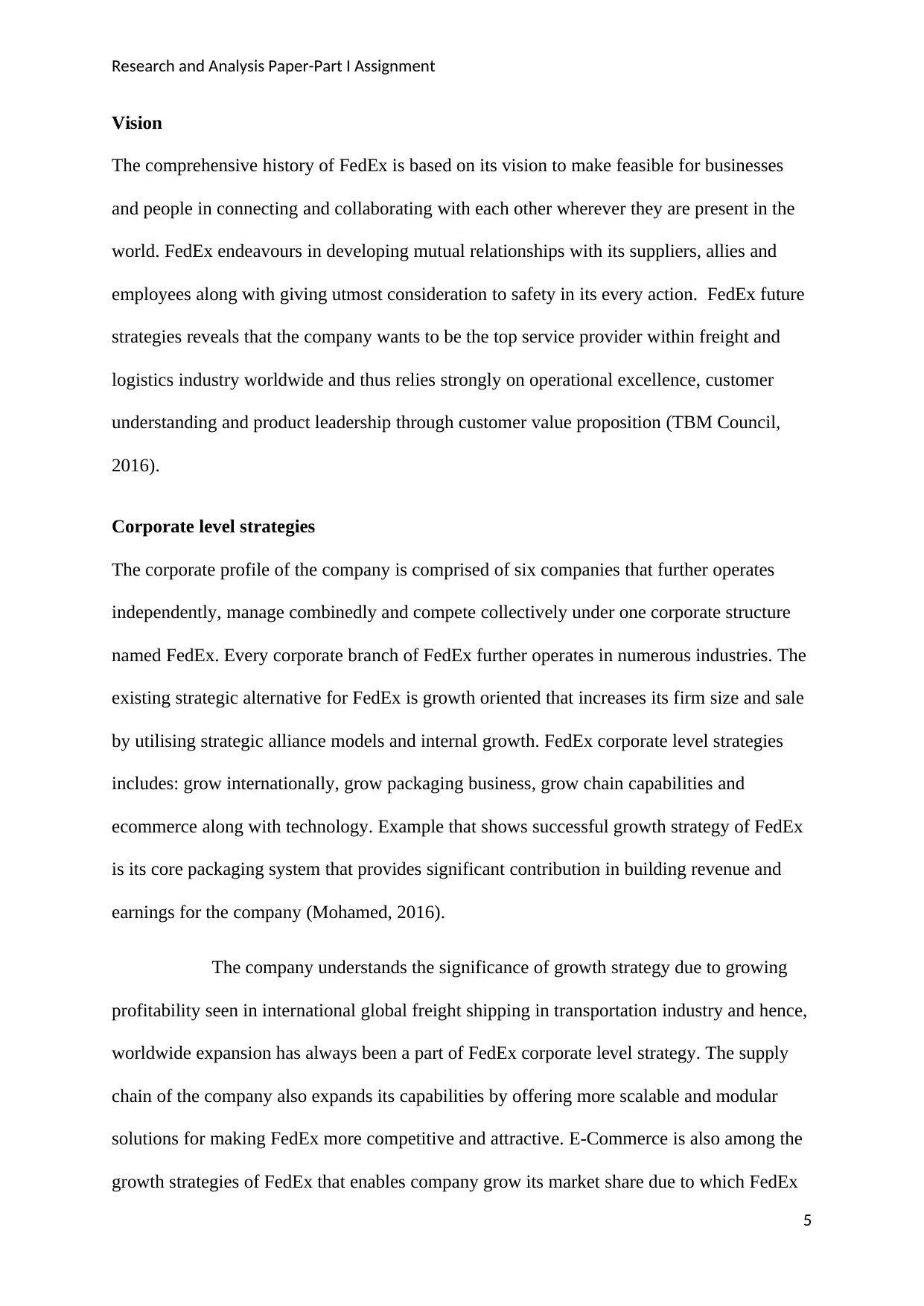
Research and Analysis Paper-Part I Assignment
Vision
The comprehensive history of FedEx is based on its vision to make feasible for businesses
and people in connecting and collaborating with each other wherever they are present in the
world. FedEx endeavours in developing mutual relationships with its suppliers, allies and
employees along with giving utmost consideration to safety in its every action. FedEx future
strategies reveals that the company wants to be the top service provider within freight and
logistics industry worldwide and thus relies strongly on operational excellence, customer
understanding and product leadership through customer value proposition (TBM Council,
2016).
Corporate level strategies
The corporate profile of the company is comprised of six companies that further operates
independently, manage combinedly and compete collectively under one corporate structure
named FedEx. Every corporate branch of FedEx further operates in numerous industries. The
existing strategic alternative for FedEx is growth oriented that increases its firm size and sale
by utilising strategic alliance models and internal growth. FedEx corporate level strategies
includes: grow internationally, grow packaging business, grow chain capabilities and
ecommerce along with technology. Example that shows successful growth strategy of FedEx
is its core packaging system that provides significant contribution in building revenue and
earnings for the company (Mohamed, 2016).
The company understands the significance of growth strategy due to growing
profitability seen in international global freight shipping in transportation industry and hence,
worldwide expansion has always been a part of FedEx corporate level strategy. The supply
chain of the company also expands its capabilities by offering more scalable and modular
solutions for making FedEx more competitive and attractive. E-Commerce is also among the
growth strategies of FedEx that enables company grow its market share due to which FedEx
5
Vision
The comprehensive history of FedEx is based on its vision to make feasible for businesses
and people in connecting and collaborating with each other wherever they are present in the
world. FedEx endeavours in developing mutual relationships with its suppliers, allies and
employees along with giving utmost consideration to safety in its every action. FedEx future
strategies reveals that the company wants to be the top service provider within freight and
logistics industry worldwide and thus relies strongly on operational excellence, customer
understanding and product leadership through customer value proposition (TBM Council,
2016).
Corporate level strategies
The corporate profile of the company is comprised of six companies that further operates
independently, manage combinedly and compete collectively under one corporate structure
named FedEx. Every corporate branch of FedEx further operates in numerous industries. The
existing strategic alternative for FedEx is growth oriented that increases its firm size and sale
by utilising strategic alliance models and internal growth. FedEx corporate level strategies
includes: grow internationally, grow packaging business, grow chain capabilities and
ecommerce along with technology. Example that shows successful growth strategy of FedEx
is its core packaging system that provides significant contribution in building revenue and
earnings for the company (Mohamed, 2016).
The company understands the significance of growth strategy due to growing
profitability seen in international global freight shipping in transportation industry and hence,
worldwide expansion has always been a part of FedEx corporate level strategy. The supply
chain of the company also expands its capabilities by offering more scalable and modular
solutions for making FedEx more competitive and attractive. E-Commerce is also among the
growth strategies of FedEx that enables company grow its market share due to which FedEx
5
⊘ This is a preview!⊘
Do you want full access?
Subscribe today to unlock all pages.

Trusted by 1+ million students worldwide
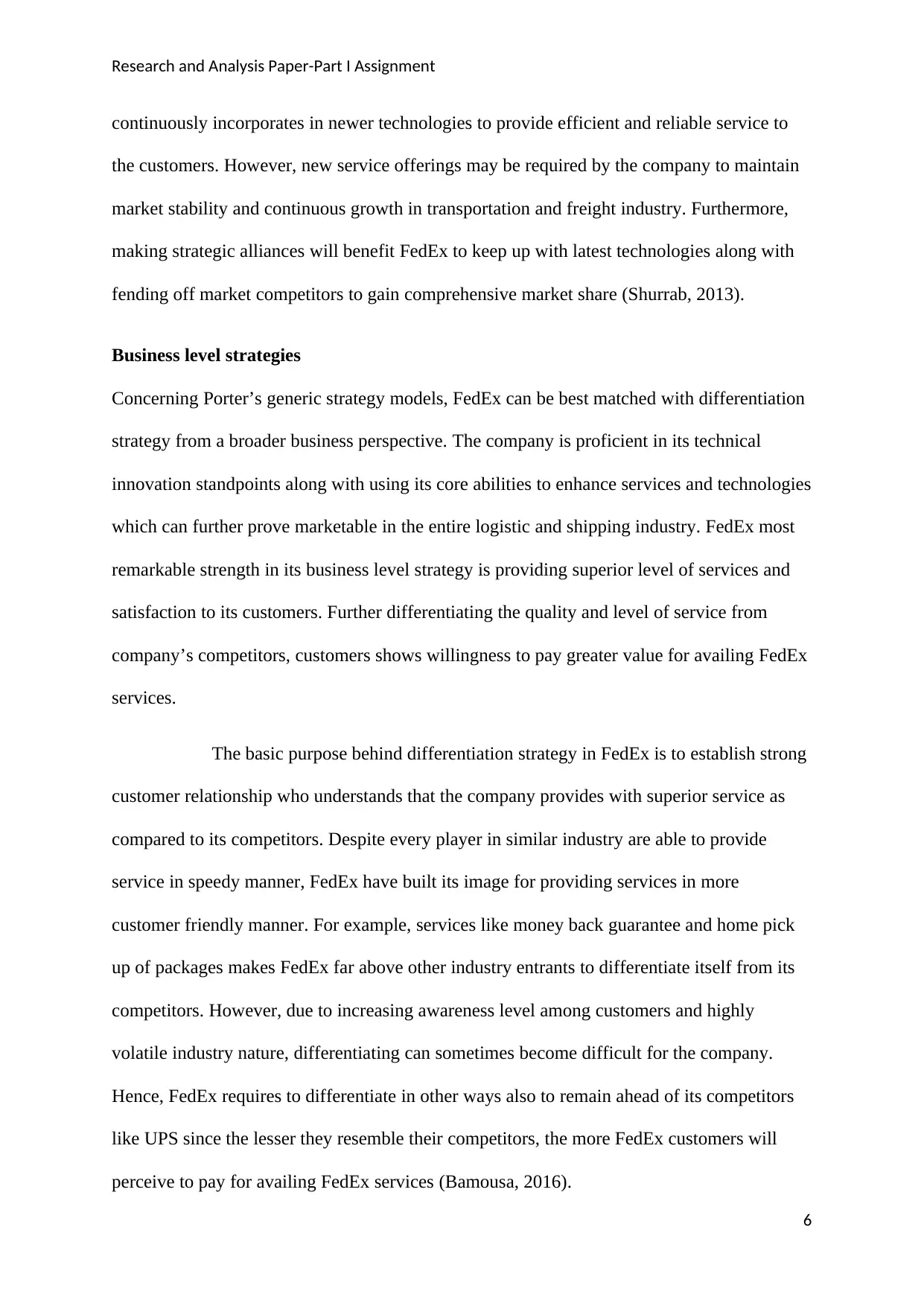
Research and Analysis Paper-Part I Assignment
continuously incorporates in newer technologies to provide efficient and reliable service to
the customers. However, new service offerings may be required by the company to maintain
market stability and continuous growth in transportation and freight industry. Furthermore,
making strategic alliances will benefit FedEx to keep up with latest technologies along with
fending off market competitors to gain comprehensive market share (Shurrab, 2013).
Business level strategies
Concerning Porter’s generic strategy models, FedEx can be best matched with differentiation
strategy from a broader business perspective. The company is proficient in its technical
innovation standpoints along with using its core abilities to enhance services and technologies
which can further prove marketable in the entire logistic and shipping industry. FedEx most
remarkable strength in its business level strategy is providing superior level of services and
satisfaction to its customers. Further differentiating the quality and level of service from
company’s competitors, customers shows willingness to pay greater value for availing FedEx
services.
The basic purpose behind differentiation strategy in FedEx is to establish strong
customer relationship who understands that the company provides with superior service as
compared to its competitors. Despite every player in similar industry are able to provide
service in speedy manner, FedEx have built its image for providing services in more
customer friendly manner. For example, services like money back guarantee and home pick
up of packages makes FedEx far above other industry entrants to differentiate itself from its
competitors. However, due to increasing awareness level among customers and highly
volatile industry nature, differentiating can sometimes become difficult for the company.
Hence, FedEx requires to differentiate in other ways also to remain ahead of its competitors
like UPS since the lesser they resemble their competitors, the more FedEx customers will
perceive to pay for availing FedEx services (Bamousa, 2016).
6
continuously incorporates in newer technologies to provide efficient and reliable service to
the customers. However, new service offerings may be required by the company to maintain
market stability and continuous growth in transportation and freight industry. Furthermore,
making strategic alliances will benefit FedEx to keep up with latest technologies along with
fending off market competitors to gain comprehensive market share (Shurrab, 2013).
Business level strategies
Concerning Porter’s generic strategy models, FedEx can be best matched with differentiation
strategy from a broader business perspective. The company is proficient in its technical
innovation standpoints along with using its core abilities to enhance services and technologies
which can further prove marketable in the entire logistic and shipping industry. FedEx most
remarkable strength in its business level strategy is providing superior level of services and
satisfaction to its customers. Further differentiating the quality and level of service from
company’s competitors, customers shows willingness to pay greater value for availing FedEx
services.
The basic purpose behind differentiation strategy in FedEx is to establish strong
customer relationship who understands that the company provides with superior service as
compared to its competitors. Despite every player in similar industry are able to provide
service in speedy manner, FedEx have built its image for providing services in more
customer friendly manner. For example, services like money back guarantee and home pick
up of packages makes FedEx far above other industry entrants to differentiate itself from its
competitors. However, due to increasing awareness level among customers and highly
volatile industry nature, differentiating can sometimes become difficult for the company.
Hence, FedEx requires to differentiate in other ways also to remain ahead of its competitors
like UPS since the lesser they resemble their competitors, the more FedEx customers will
perceive to pay for availing FedEx services (Bamousa, 2016).
6
Paraphrase This Document
Need a fresh take? Get an instant paraphrase of this document with our AI Paraphraser

Research and Analysis Paper-Part I Assignment
SWOT analysis
FedEx corporation provides with broad range of logistics and transportation, e-commerce and
business-related services to its customers under one brand name FedEx. The strong marketing
position of the company and diversified business activities are major strengths of FedEx.
Weaknesses can be seen in few of its operational efficiencies along with return on equity that
remains the area of concern. The intense market competition and global economic condition
may impede the company’s growth. Nevertheless, positive short-term and long-term outlooks
along with strategic expansion in logistics and air freight may offer significant growth
opportunities to FedEx (Bamousa, 2016).
Strengths
FedEx poses many strengths as they are very innovative and always coming with new ideas
to add value to their clientele’s experience. The wireless technology implemented by the
company to track packages along with launching personal website to allow customers track
their orders are few among many other innovative practices followed by the company. FedEx
owns large fleet of planes along with extensive hubs and networks that extends in more than
220 countries worldwide. Since last 30 years, FedEx is been led by Frederick W Smith’s
strong leadership control and through his dedication and strong commitment towards the
company, FedEx have reached to its pinnacle (Shurrab, 2013).
Weaknesses
The weaknesses of FedEx derive from its inability seen in few operational levels as well as
differentiation strategies that hinders company’s ability to achieve competitive position in
worldwide market. Another weakness observed is in its cost related strategies where few of
its services proves costly due to high expenditure cost of company’s infrastructure and
logistics. Therefore, they are unable to reduce their service costs that takes huge market share
towards UPS. Labour disputes in internal management of FedEx also adds to its weaknesses
7
SWOT analysis
FedEx corporation provides with broad range of logistics and transportation, e-commerce and
business-related services to its customers under one brand name FedEx. The strong marketing
position of the company and diversified business activities are major strengths of FedEx.
Weaknesses can be seen in few of its operational efficiencies along with return on equity that
remains the area of concern. The intense market competition and global economic condition
may impede the company’s growth. Nevertheless, positive short-term and long-term outlooks
along with strategic expansion in logistics and air freight may offer significant growth
opportunities to FedEx (Bamousa, 2016).
Strengths
FedEx poses many strengths as they are very innovative and always coming with new ideas
to add value to their clientele’s experience. The wireless technology implemented by the
company to track packages along with launching personal website to allow customers track
their orders are few among many other innovative practices followed by the company. FedEx
owns large fleet of planes along with extensive hubs and networks that extends in more than
220 countries worldwide. Since last 30 years, FedEx is been led by Frederick W Smith’s
strong leadership control and through his dedication and strong commitment towards the
company, FedEx have reached to its pinnacle (Shurrab, 2013).
Weaknesses
The weaknesses of FedEx derive from its inability seen in few operational levels as well as
differentiation strategies that hinders company’s ability to achieve competitive position in
worldwide market. Another weakness observed is in its cost related strategies where few of
its services proves costly due to high expenditure cost of company’s infrastructure and
logistics. Therefore, they are unable to reduce their service costs that takes huge market share
towards UPS. Labour disputes in internal management of FedEx also adds to its weaknesses
7
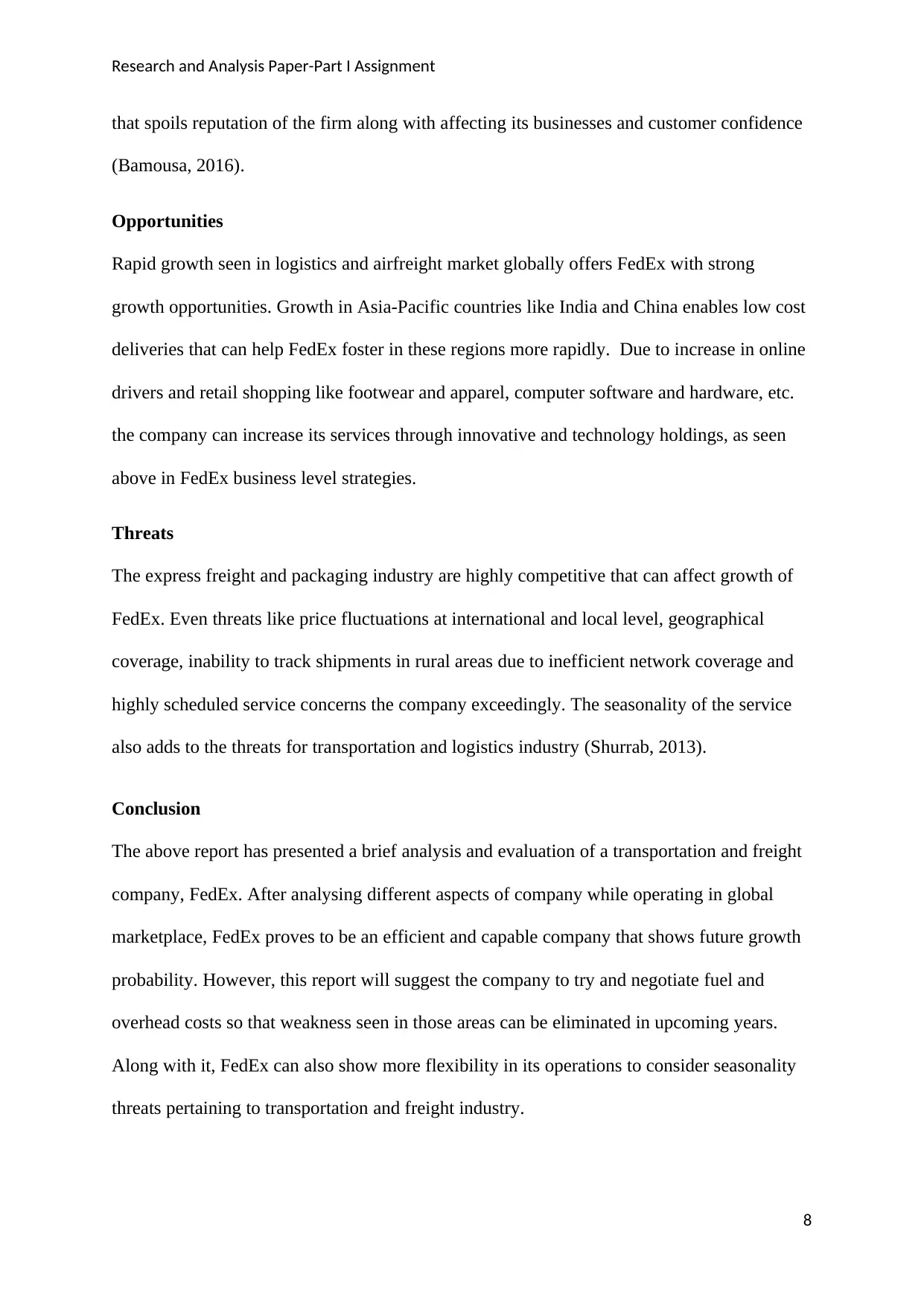
Research and Analysis Paper-Part I Assignment
that spoils reputation of the firm along with affecting its businesses and customer confidence
(Bamousa, 2016).
Opportunities
Rapid growth seen in logistics and airfreight market globally offers FedEx with strong
growth opportunities. Growth in Asia-Pacific countries like India and China enables low cost
deliveries that can help FedEx foster in these regions more rapidly. Due to increase in online
drivers and retail shopping like footwear and apparel, computer software and hardware, etc.
the company can increase its services through innovative and technology holdings, as seen
above in FedEx business level strategies.
Threats
The express freight and packaging industry are highly competitive that can affect growth of
FedEx. Even threats like price fluctuations at international and local level, geographical
coverage, inability to track shipments in rural areas due to inefficient network coverage and
highly scheduled service concerns the company exceedingly. The seasonality of the service
also adds to the threats for transportation and logistics industry (Shurrab, 2013).
Conclusion
The above report has presented a brief analysis and evaluation of a transportation and freight
company, FedEx. After analysing different aspects of company while operating in global
marketplace, FedEx proves to be an efficient and capable company that shows future growth
probability. However, this report will suggest the company to try and negotiate fuel and
overhead costs so that weakness seen in those areas can be eliminated in upcoming years.
Along with it, FedEx can also show more flexibility in its operations to consider seasonality
threats pertaining to transportation and freight industry.
8
that spoils reputation of the firm along with affecting its businesses and customer confidence
(Bamousa, 2016).
Opportunities
Rapid growth seen in logistics and airfreight market globally offers FedEx with strong
growth opportunities. Growth in Asia-Pacific countries like India and China enables low cost
deliveries that can help FedEx foster in these regions more rapidly. Due to increase in online
drivers and retail shopping like footwear and apparel, computer software and hardware, etc.
the company can increase its services through innovative and technology holdings, as seen
above in FedEx business level strategies.
Threats
The express freight and packaging industry are highly competitive that can affect growth of
FedEx. Even threats like price fluctuations at international and local level, geographical
coverage, inability to track shipments in rural areas due to inefficient network coverage and
highly scheduled service concerns the company exceedingly. The seasonality of the service
also adds to the threats for transportation and logistics industry (Shurrab, 2013).
Conclusion
The above report has presented a brief analysis and evaluation of a transportation and freight
company, FedEx. After analysing different aspects of company while operating in global
marketplace, FedEx proves to be an efficient and capable company that shows future growth
probability. However, this report will suggest the company to try and negotiate fuel and
overhead costs so that weakness seen in those areas can be eliminated in upcoming years.
Along with it, FedEx can also show more flexibility in its operations to consider seasonality
threats pertaining to transportation and freight industry.
8
⊘ This is a preview!⊘
Do you want full access?
Subscribe today to unlock all pages.

Trusted by 1+ million students worldwide
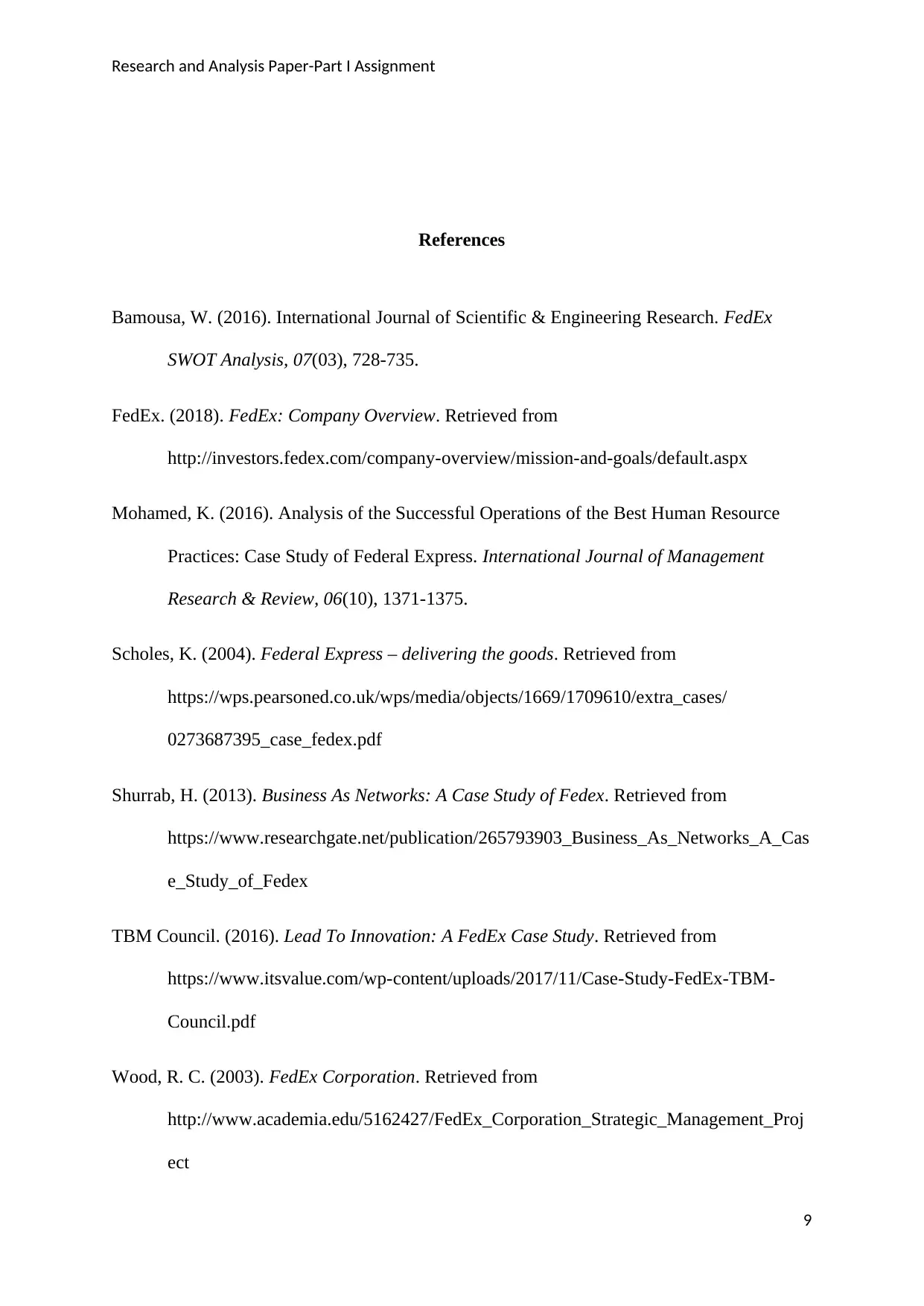
Research and Analysis Paper-Part I Assignment
References
Bamousa, W. (2016). International Journal of Scientific & Engineering Research. FedEx
SWOT Analysis, 07(03), 728-735.
FedEx. (2018). FedEx: Company Overview. Retrieved from
http://investors.fedex.com/company-overview/mission-and-goals/default.aspx
Mohamed, K. (2016). Analysis of the Successful Operations of the Best Human Resource
Practices: Case Study of Federal Express. International Journal of Management
Research & Review, 06(10), 1371-1375.
Scholes, K. (2004). Federal Express – delivering the goods. Retrieved from
https://wps.pearsoned.co.uk/wps/media/objects/1669/1709610/extra_cases/
0273687395_case_fedex.pdf
Shurrab, H. (2013). Business As Networks: A Case Study of Fedex. Retrieved from
https://www.researchgate.net/publication/265793903_Business_As_Networks_A_Cas
e_Study_of_Fedex
TBM Council. (2016). Lead To Innovation: A FedEx Case Study. Retrieved from
https://www.itsvalue.com/wp-content/uploads/2017/11/Case-Study-FedEx-TBM-
Council.pdf
Wood, R. C. (2003). FedEx Corporation. Retrieved from
http://www.academia.edu/5162427/FedEx_Corporation_Strategic_Management_Proj
ect
9
References
Bamousa, W. (2016). International Journal of Scientific & Engineering Research. FedEx
SWOT Analysis, 07(03), 728-735.
FedEx. (2018). FedEx: Company Overview. Retrieved from
http://investors.fedex.com/company-overview/mission-and-goals/default.aspx
Mohamed, K. (2016). Analysis of the Successful Operations of the Best Human Resource
Practices: Case Study of Federal Express. International Journal of Management
Research & Review, 06(10), 1371-1375.
Scholes, K. (2004). Federal Express – delivering the goods. Retrieved from
https://wps.pearsoned.co.uk/wps/media/objects/1669/1709610/extra_cases/
0273687395_case_fedex.pdf
Shurrab, H. (2013). Business As Networks: A Case Study of Fedex. Retrieved from
https://www.researchgate.net/publication/265793903_Business_As_Networks_A_Cas
e_Study_of_Fedex
TBM Council. (2016). Lead To Innovation: A FedEx Case Study. Retrieved from
https://www.itsvalue.com/wp-content/uploads/2017/11/Case-Study-FedEx-TBM-
Council.pdf
Wood, R. C. (2003). FedEx Corporation. Retrieved from
http://www.academia.edu/5162427/FedEx_Corporation_Strategic_Management_Proj
ect
9
Paraphrase This Document
Need a fresh take? Get an instant paraphrase of this document with our AI Paraphraser

Research and Analysis Paper-Part I Assignment
10
10
1 out of 11
Related Documents
Your All-in-One AI-Powered Toolkit for Academic Success.
+13062052269
info@desklib.com
Available 24*7 on WhatsApp / Email
![[object Object]](/_next/static/media/star-bottom.7253800d.svg)
Unlock your academic potential
Copyright © 2020–2025 A2Z Services. All Rights Reserved. Developed and managed by ZUCOL.




